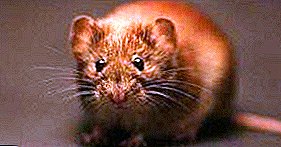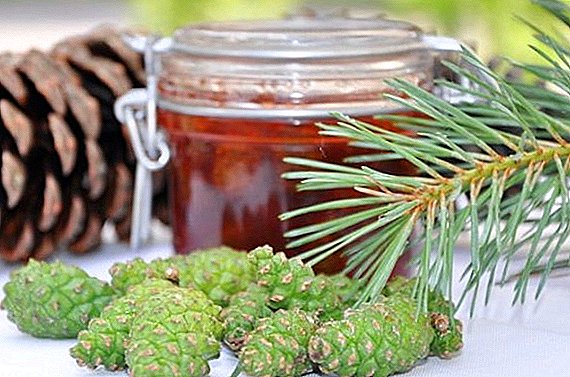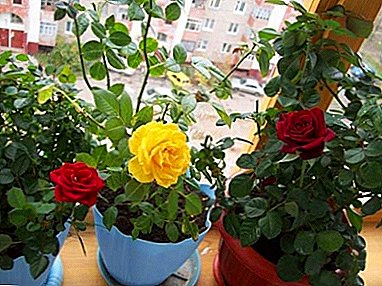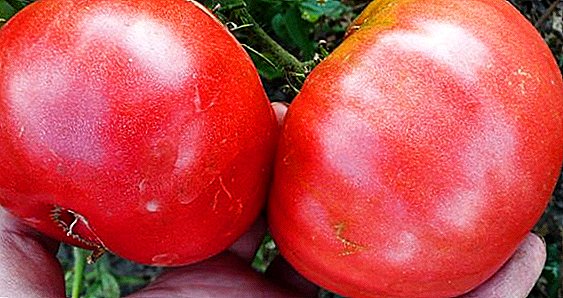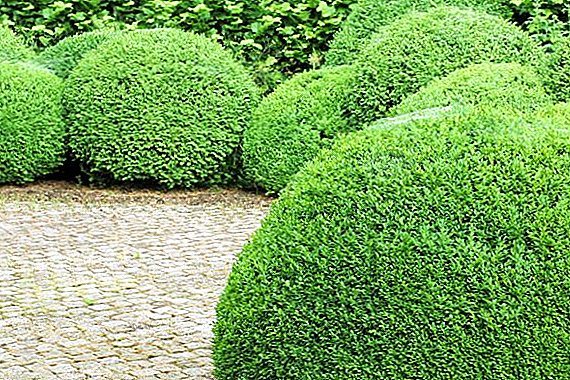 Today, many gardeners grow on their plots not only vegetables and fruits, but also plants that are able to decorate the area. These are, without doubt, ornamental shrubs and the abundance of their types and forms will allow to satisfy any requirements. In this article you will find information about the most popular types of such plants, which will help determine the situation of choice and choose the most appropriate decoration for your site.
Today, many gardeners grow on their plots not only vegetables and fruits, but also plants that are able to decorate the area. These are, without doubt, ornamental shrubs and the abundance of their types and forms will allow to satisfy any requirements. In this article you will find information about the most popular types of such plants, which will help determine the situation of choice and choose the most appropriate decoration for your site.
Purpose of ornamental shrubs in the country
 Apply bush ornamental plants for your garden can be different. For example, undersized are considered a universal decoration, as they can be arranged in a separate composition, grown as a hedge, border around a flower bed or along paths. In addition, they are often used for rabatok. Shrubs on a larger divide the area into zones. A hedge of such plants will protect from sunlight. It is good to decorate unsightly walls with tall decorative bushes, to shade the desired garden areas. They are suitable for single landings.
Apply bush ornamental plants for your garden can be different. For example, undersized are considered a universal decoration, as they can be arranged in a separate composition, grown as a hedge, border around a flower bed or along paths. In addition, they are often used for rabatok. Shrubs on a larger divide the area into zones. A hedge of such plants will protect from sunlight. It is good to decorate unsightly walls with tall decorative bushes, to shade the desired garden areas. They are suitable for single landings.
Fruit, flowering mini-trees will be a bright accent and decoration. In the spring, they will delight you with a pleasant aroma, and in the fall - with a beautiful color of leaves. In addition, the fruits themselves are a worthy reward for the cottager for all the works. Some plants make the garden design complete, but conifers, however, as well as evergreen shrubs will be the highlight of any plot. They are planted in the center of the compositions and planted as a fence in large areas. Unusually they look in combination with flower plants, for example, a rose. But, it is necessary to take into account the fact that not every rose will fit such neighbors.
Did you know? There is such a type of ornamental plants as "aquarium plants".
Types of ornamental shrubs
There are several types of ornamental shrubs based on different characteristics.
So, given the frost resistance, emit very cold-resistant (Siberian hawthorn, Siberian deren, elfin cedar, mountain pine), cold resistant (Tatar honeysuckle, common hawthorn, ordinary viburnum, western thuja, etc.) and moderately cold-resistant (dog rose, Chubushnik, Japanese quince, common privet, etc.).
Based on the requirements of plants in lighting, the variety of ornamental shrubs are divided into photophilous (lilac, rowan rybinolistny, hips, etc.), semi-shine-resistant (calyxes, chubushnik, red elderberry, yellow acacia), shade-tolerant (hazel, red turf, warty euonymus, common privet, etc.). Also isolated flowering, decorative leafy, fruit plants.
You can classify types of ornamental shrubs and rely on plant growth (undersized, medium tall, tall) or the period of their greatest decoration. For example, magnolia is most decorative in spring, rose in summer, rowan in autumn, and berry yew in winter.
Did you know? The general classification of shrubs divides them into 4 classes: rosettes, parasitic and semi-parasitic, succulent-stemless leafless and shrubs with fully lignified long shoots.
List of ornamental shrubs for the garden with a description and photo
Next, we will talk about some of the most interesting, popular garden bushes, with their names and descriptions.
Fruit ornamental shrubs for summer cottage
Such plants not only serve as a decoration for the garden, but also provide benefits, but often require more maintenance.
Felt cherry. This shrub has gained popularity among gardeners for its capricious nature, consistently good yield and fairly compact size. In the period of flowering is abundantly covered with pale pink flowers. Light fluff, similar to felt, covers the leaflets and shoots (for this plant it got its name). It is preferable to plant such ornamental shrubs in an open, well-lit part of the garden, in a soil rich in organic matter.
Viburnum. A very popular plant in our gardens. It is considered a strong amulet. It blooms in May and June with white flowers with a honey aroma. In autumn, the fruits turn red and decorate the bush all winter. Kalina is not capricious, it grows and bears fruit in almost any part of the garden.
Rosehip. Refers to such ornamental shrubs, whose names are associated with medicinal plants, as the benefits of its fruits, rich in vitamin C, everyone has heard. There are species that are characterized by beautiful double flowers, which are not inferior to roses in their beauty, although there are also those that make a dense and barbed fence. This is an extremely unpretentious plant that easily tolerates transplantation and pruning. Grows fast. Sustains partial shade, but grows better in sunny places.
Gooseberry. Keeps fruiting for about 25 years. But, if you decide which shrubs to plant in front of the house in conditions of very high humidity and severe frosts, then this bush will not work for you, as it does not tolerate such climatic conditions. In temperate zones, infrequent watering in summer and shelter in winter will suffice. Gooseberries are often grown along the fence and eventually get a solid green wall. The fruits are very useful because they contain a lot of vitamin C, phosphorus and trace elements.
Cold resistant shrubs
Often, summer residents choose such ornamental shrubs for their plot, which not only delight the eye in summer, but are also able to withstand cold and windy winters. We will tell about some of them.
Shrub pyatilniki (also called "Kuril tea ") - extremely cold-resistant plant that can grow even in permafrost conditions. It grows up to 1.5 m in height. It blooms from July until the end of summer. Its fruit, ripening in early autumn, can be used to make tea.
Frost resistant weigela - very beautiful, picturesque ornamental bushes. They are unpretentious, and any soil will be suitable for their cultivation. May grow quietly in the penumbra, but a well-lit area would be much preferable. Do not require abundant and frequent watering. Grow quickly to 2 m, and bloom in the second year. Flowering occurs from May to June and is characterized by bright pink inflorescences on the bushes, after which they are pleased with bright, green foliage.
Such a shrub as snowberry also tolerates winter frosts. The flowering period is at the beginning of summer and lasts until September. White flowers, similar to lilies of the valley, and whitish fruits, which appear on the branches all winter, are inedible. It grows to a maximum of 2 m tall. Shrub light-requiring, and to other conditions has no special requirements.
Did you know? In total, there are about 50 species of frost-resistant shrubs used for decorative purposes in the middle zone of the country.
Coniferous ornamental shrubs
Coniferous ornamental shrubs are considered a mandatory item in almost any landscape design solution. The most popular among them are the following.
Juniper. There are tall, narrow and stunted, razlapistye varieties. Several of these plants, planted in a group, beautifully combined with large stones. Plants calmly relate to shade and frost. Able to tolerate even freezing rain.
Pine Mountain Pumilmo - It is a dwarf compact coniferous bush, which is widely used in gardening. It has dark green needles, 3-5 cm long. It grows up to 1.5 m in height and 3 m in diameter. It grows better in sunny places, makes a little shading, but in the shade will wither. Prefers quite fertile soil, but will grow on any other. Frost-and drought-resistant plant.
Important! Poor tolerance of soil compaction, stagnant waterlogging.
Cypress Shrubs are both thermophilic and frost-resistant, but they feel better in shaded places. Do not require additional care, have a dark green color needles, spectacular appearance.
Cryptomeria. It is best to grow this plant in a sunny place. There are dwarf and tall varieties that attract attention to themselves in various ways. For example, Japanese cryptomeria is interesting because it acquires a reddish-brown color in winter.
Yew treats slowly growing coniferous bushes. There are species that are often used for hedges (for example, yew berry), there are dwarfs (60 cm in height), there are those that form rounded bushes (yew average). It grows in the sun and in partial shade. 
Evergreen Ornamental Shrubs
To evergreen deciduous shrubs we assign evergreen magnolia. It is popular as a hedge. Capable of self-growth root shoots. It blooms from late May to mid-June with inflorescences of yellow color. The rest of the time pleases the eye with bright foliage and clusters of dark berries. Any lighting will do for her, but stagnant water will lead to rotting of the roots.
Ling applies not only to plants with a long flowering period (second half of summer), but also to shrubs with decorative foliage that does not lose its beauty even in winter. Its height is only 60 cm, that is, it is a short shrub. He is picky about the composition of the soil, but needs an abundance of sunlight.
Some varieties derena there are also evergreens that retain their decoration throughout the year. Derain does not require special care, because it is unpretentious to the soil, shade-tolerant plant with good adaptation.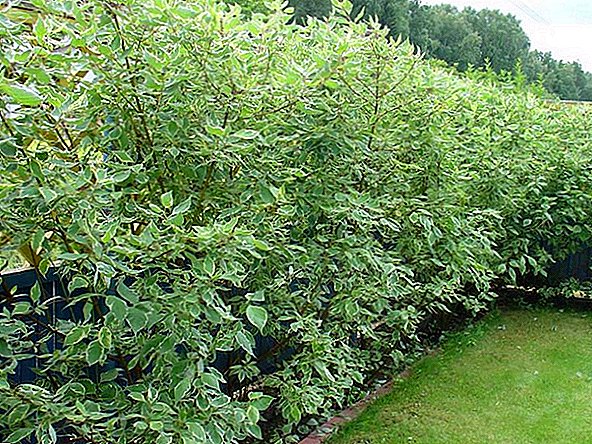
Holly (holly). Its evergreen forms can be green or variegated with shiny leathery leaves. Blooms with inconspicuous small flowers. Fruits are poisonous, and ripening in the fall, they remain on the plant throughout the winter. It tolerates pruning, shade-tolerant, prefers moist soils.
Features of growing ornamental shrubs in the garden
In addition, it is necessary to choose which bushes to plant in the country, you also need to know the basics of their agricultural technology, otherwise the beauty of the bushes will not long please you.
Important! It is necessary to plant ornamental shrubs in the fall, before the onset of frosts, or in the spring, in the time interval between thawing of the soil and the awakening of the kidneys.
Prepare the pits for spring planting in the autumn and fill them with fertilizers, while direct planting will only fit them to the size of the root system of the plant. When buying seedlings, make sure that the roots do not dry out, and before planting, put them in water for several hours. You can add growth stimulants. Be sure to remove the affected parts of the roots. Also remember that ornamental shrubs need space. Stunted planted at a distance of 70-80 cm, medium - 1.2-1.5 m, tall - at least 2 m. Ornamental shrubs need periodic pruning, mulching and care, taking into account the characteristics of a particular type and variety.  We told you about the purpose, types of ornamental shrubs, provided names and descriptions of some of them, and resulted in several requirements for their cultivation. Choose according to your taste and decorate your site, sure that you can find something for yourself in such a huge list.
We told you about the purpose, types of ornamental shrubs, provided names and descriptions of some of them, and resulted in several requirements for their cultivation. Choose according to your taste and decorate your site, sure that you can find something for yourself in such a huge list.



